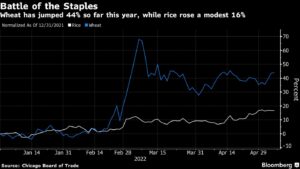As 2026 ushers in a fresh start, agricultural economists say the U.S. farm economy has stopped sliding, but it’s far from fully healed.The December Ag Economists’ Monthly Monitor shows month-to-month…
Global Food Prices Ease Slightly From Record, as Ukrainian Exports Foiled; and Global Wheat Variables Evolve
Bloomberg writer Megan Durisin reported on Friday that, “Global food prices held near a record as crop trade is disrupted by the war in Ukraine, exacerbating tight supplies and stoking inflation.

“Russia’s invasion has reduced exports from Ukraine to a trickle, curbing supplies from one of the world’s biggest grain and vegetable oil shippers. That’s sent buyers flocking elsewhere, while some nations are moving to restrict sales as they worry about depleting local reserves.
“High fertilizer prices and weather worries are adding to the threat for global crop supplies, including drought curbing the U.S. wheat crop. That risks compounding a deepening hunger crisis. A United Nations food index eased less than 1% in April, holding near an all-time high.”
Also Friday, Dow Jones writer Yusuf Khan reported that, “Food prices in April moved lower from an all-time high in March, as a drop in vegetable-oil prices managed to marginally mitigate the effects of the war in Ukraine and supply-chain issues globally, according to the United Nations Food and Agriculture Organization.
The FAO’s Food Prices Index, a measure of the most commonly-traded food commodities, fell slightly to 158.5 points in April, from March’s record high of 159.3 points. The April figure marks a 0.8% reduction in prices on month but was still 30% higher than April 2021.”
Meanwhile, Reuters writer Pavel Polityuk reported late last week that, “Ukraine has imposed temporary restrictions on the supply of grain cargoes by rail in the direction of Moldova and Romania due to a large number of wagons at border crossings, the APK-Infrom consultancy said on Friday.
“After its Black Sea ports were blocked by Russia, Ukraine has been forced to use rail as its main route for exporting grain, which often leads to the accumulation of wagons at border crossings.
“Earlier, Kyiv suspended grain exports by rail to Poland.”
The Reuters article noted that, “The agriculture ministry said on Thursday that grain exports had reached 46 million tonnes in the 2021/22 July-June season, including 132,000 tonnes so far in May.”
A separate Reuters article last week reported that, “A U.N. food agency official said on Friday that nearly 25 million tonnes of grains was stuck in Ukraine and unable to leave the country due to infrastructure challenges and blocked ports in the Black Sea.”
And, Reuters writer Pavel Polityuk reported last week that, “Ukraine hopes to grow export capacity by 50% in the next few months by expanding facilities on its western border, but it will still be far short of pre-war levels, the deputy infrastructure minister said on Friday.”
“Ukraine, a major global grain grower and exporter, has sharply reduced its grain exports since start of the Russian invasion to around 1 million tonnes in April from up to 6 million tonnes before the war,” the article said.
New York Times writers Marc Santora, Cora Engelbrecht and Michael Levenson reported in Saturday’s paper that, “The United Nations said on Friday that there was mounting evidence that Russian troops had looted tons of Ukrainian grain and destroyed grain storage facilities, adding to a disruption in exports that has already caused a surge in global prices, with devastating consequences for poor countries.”
In other news, Bloomberg writers Pratik Parija and Bibhudatta Pradhan reported last week that, “A growing food security threat is set to push Indian Prime Minister Narendra Modi into a conundrum: continue sending wheat to countries hit by dwindling supplies from the war in Ukraine or stockpile food at home to fend off high inflation.
“Severe heat waves have damaged wheat yields across the South Asian nation, prompting the government to consider export restrictions, Bloomberg News reported. While the food ministry said it sees no case yet for controlling wheat exports, it’s a question that will gain momentum and carry political ramifications for Modi and his ruling Bharatiya Janata Party.”
The article noted that, “Franck Gbaguidi, senior analyst at political risk consultancy Eurasia Group, said damage to crops will limit India’s ability to fill broader supply shortages, regardless of whether exports move forward or not. Wheat consumption in the world’s second-most populous nation is estimated at 107.9 million tons, according to the U.S. Department of Agriculture.”
And Bloomberg writer Eamon Akil Farhat reported today that, “Global wheat prices are so high that African consumers are starting to ditch the grain from their diet.

“Food producers in Kenya, Egypt, Democratic Republic of Congo, Nigeria and Cameroon say they’re mixing cheaper alternatives into their breads, pastries and pastas. Local rice, manioc flour and sorghum are substituting for wheat, which has spiked about 40% this year as Russia’s invasion squeezed exports from Ukraine, one of the biggest shippers.”
And Reuters writer Nicolas Misculin reported on Friday that, “Australia and New Zealand have approved the sale and use of foods that contain so-called HB4 wheat, a genetically modified (GMO) variety developed by Argentine firm Bioceres to withstand droughts and herbicides, the firm said on Friday.
“Argentina, one of the world’s largest wheat exporters, was the first country to approve GMO wheat in 2020, followed by Brazil in 2021, a trend that could continue if global supply is further constrained by Russia’s invasion of Ukraine.”





